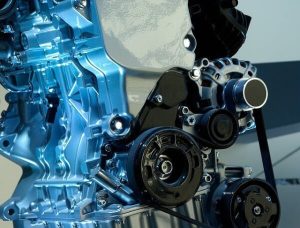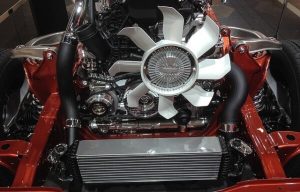Prior to the mid-1980’s, automobiles used to have multiple engine belts running the vehicle’s whole machinery. In essence, there used to be a different and much thinner belt for each component such as the alternator, water pump, air pump and power steering pump. But in 1985, Mercedes-Benz pioneered the use of a thick singular engine belt that runs all the necessary gears of an automobile.
The serpentine belt was designed for overall efficiency. A single belt that for conveys all engine components has more tension than several engine belts. As a result, the automobile runs smarter. In older vehicle models, only certain functions break down when a single belt is damaged. It often proves more dangerous to some extent since an automobile may continue to move even after the brakes and steering wheels malfunction. A damage on a serpentine belt means the car malfunctions altogether – a necessary hassle that serves as a security net from certain traffic hazards.
When an engine runs smarter, it functions without expending too much fuel. Hence, it significantly reduces the cost needed to fill up the tank. Lastly, the increased tension from a thicker and more durable singular rubber conveyor means it requires less repair frequency – making the serpentine belt replacement cost a better investment than its predecessor.
Average Cost Estimate

There are two aspects that determine the average cost to replace serpentine belt. It is important to take note that exact fees differ depending on the type of car or the service provider. Lastly, the costs projected in this assessment exclude taxes.
Belt
One important component of determining the cost to replace serpentine belt is the belt itself. The national average estimate is somewhere within $25 to $75 cost bracket. This does not include other engine belt components such as the tensioner or the pulley. Purchasing a spare serpentine belt may cost as low as $10 for its bargain price.
Labor
Another important aspect of the serpentine belt replacement cost is the labor cost. As far as the national average estimate is concerned, mechanics usually charge $75 to $120 per hour for their work. In some cases, a less complicated engine setup would only take at least half an hour to finish. Other mechanics may have a different fee setup.
Price Based On Automobile Brands
A clearer perspective on the projected serpentine belt replacement cost requires keen recognition of various automobile types. A website called Repair Pal demonstrates a probable chart based on the most popular car brands in the United States. These are the comprehensive prices for repair service according to expert assessment.
Chrysler Town & Country
Total Average: $88 to $139
Labor Cost: $61 to $78 + Belt Parts: $27 to $61
Jeep Cherokee
Total Average: $82 to $107
Labor Cost: $44 to $56 + Belt Parts: $38 to $51
Cadillac Seville
Total Average: $100 to $128
Labor Cost: $44 to $56 + Belt Parts: $56 to $72
BMW 325i
Total Average: $121 to $165
Labor Cost: $70 to $89 + Belt Parts: $51 to $76
Buick Century
Total Average: $74 to $101
Labor Cost: $35 to $45 + Belt Parts: $39 to $56
Subaru Legacy
Total Average: $110 to $149
Labor Cost: $61 to $78 + Belt Parts: $49 to $71
Possible Additional Costs
When it comes to the serpentine belt breakdown, the one operational disadvantage that most people detest is the complete automobile halt. This means that a car will stop dead in the middle of the highway when the serpentine belt is already way past its exhaustible tension threshold. The owner will have to add the fee for towing service in his or her overall cost to replace serpentine belt. This means an addition $200 or more on top of the outstanding repair fee.
In some cases, other engine components turning the serpentine belt may also need replacement. The cost to replace an idler pulley, for instance, is anywhere between $13 and $33.
On top of the key sections of the serpentine belt, the assigned mechanic may see other damages in the engine that requires fixing. The additional cost may largely depend on what needs to be resolved. It is for this reason alone that car owners must have a working knowledge of the parts and functions of their vehicle’s engine. Inspection is a crucial step in projecting total repair costs.
5-Step Serpentine Belt Inspection
When a car fails to run, anyone with a basic working knowledge of automobile engineering would assume that the serpentine belt may need replacement. Knowing what went wrong with the engine gives car owners a clearer idea regarding how much they will be spending in their next appointment with a mechanic.
It is even possible to avoid labor costs if some problems could be addressed independently. These are the steps highlighted by the website called Auto Parts Warehouse:

Step 1: Consult Owner’s Manual
Different automobiles have their own unique engine setup. The manual can point out where the belt is located in the midst of the complex engine structure.
Step 2: Seek Oil Leakage
The smooth side of the belt steers the car’s water pump. When oil drenches this part of the belt, it effectively loses traction and eventually fails to keep the engine cool. Oftentimes the problem with serpentine belts slipping out of the gear has nothing to do with the belt itself. The oil leakage, therefore, needs to be diagnosed and addressed.
Step 3: Check For Abrasions
Sometimes the belt is torn because of the abrasiveness of the pulley flange. Car experts advise on smoothing its edges in order to prolong the serpentine belt’s performance.
Step 4: Clear Grit And Debris
In most cases, serpentine belts malfunction due to the accumulation of dirt around the areas between the belt and the pulley. In fact, it is possible to determine whether components are due for replacement by way of looking at belt’s rib area. A clear indication for replacing the serpentine belt is if such area is losing too many chunks.
Step 5: Measure Cracks
Serpentine belts rely on their tensile strength. Certain cracks are normal but if they are often 3 millimeters apart, this is a clear indicator that the belt needs to be replaced.
